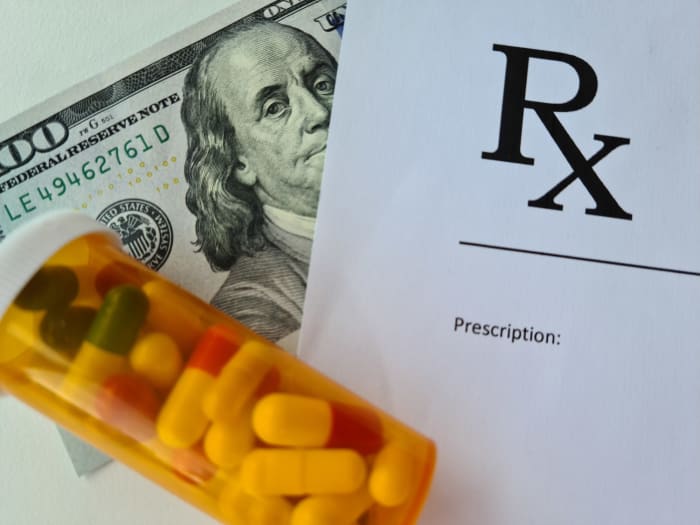Medicare enrollees are paying far more than their prescription-drug plans for dozens of drugs covered under Medicare Part D, according to a new study from the U.S. Government Accountability Office.
For 79 drugs studied by the GAO, Medicare patients’ 2021 spending totaled $21 billion — roughly quadruple the amount that Part D plans spent on those drugs, after accounting for “rebates,” or discounts that drugmakers often pay to Part D plan sponsors or the prescription-drug middlemen known as pharmacy-benefit managers.
The GAO’s figures focus on drugs with the highest rebates. Drugmakers frequently offer higher rebates as part of agreements with Part D plans designed to boost their drugs’ utilization and market share — for example, paying higher rebates if there are fewer competing drugs with similar placement on the plan’s formulary, or list of covered drugs, the GAO report said.
Part D plan sponsors got more than $48 billion in rebates from drug companies in 2021, but the patients who take the medicines that are generating all those savings are losing out, the study suggests. The reason: Medicare Part D enrollees’ costs at the pharmacy counter are based on the drug’s gross cost before any rebates, the GAO said.
About three-fourths of the rebates for Part D drugs came from just three groups of medicines: Endocrine metabolic agents, such as insulin used by many diabetics; blood modifiers such as anti-stroke medications; and respiratory drugs including anti-asthma medications. Those discounts don’t directly lower costs for patients taking those drugs but may help trim total Part D spending and lower overall premiums for enrollees, according to the study. That means that patients taking highly rebated drugs may be effectively subsidizing lower premiums for all enrollees, researchers say.
This is what the drug-pricing research nonprofit 46brooklyn Research calls “money from sick people” — and it’s an issue that pervades commercial insurance markets as well as Medicare, said 46brooklyn CEO Antonio Ciaccia. “It’s the opposite of what insurance is supposed to be,” he said. If you’re a sick patient, he said, “you’re stuck paying bogus, inflated prices for the purpose of generating rebates that accrue to other people,” benefiting corporate players and healthier people who don’t take medicines.
About 50 million people are enrolled in Medicare Part D prescription-drug coverage. Total Part D spending topped $200 billion in 2021.
In addition to disproportionately burdening patients taking highly rebated drugs, the discounts can also incentivize Part D plans to give preferred formulary placement to more established drugs with bigger rebates rather than newer, competing drugs that may enter the market with lower costs and fewer rebates, researchers say. Rebates are often “tied to limiting or excluding other competitors in a similar therapeutic class,” John Dicken, director for health care at the GAO, told MarketWatch.
Drugmakers often pay higher rebates, for example, if their drug is the only medicine in a given competitive group with preferred placement on the plan’s formulary, the GAO study said. Some rebate agreements state specifically that the rebates will be cut off entirely if a competing generic gets similar placement on the plan’s formulary, according to the study. “The actual marketplace is competitive and is creating benefit, but the benefit is not accruing to the patient,” who may be forced to keep paying higher costs for a brand-name drug even when a cheaper generic is available, Ciaccia said.
Looking at 40 highly rebated brand-name drugs and their generic equivalents, for example, the GAO found that about a quarter of the Part D plans studied listed the brand-name drug on their formularies but not the generic alternative. Nearly 80% of the rebate dollars for those drugs were paid to plans that did not list the generic alternative on the formulary, the study found.
The Federal Trade Commission announced last year that it would ramp up enforcement against rebate arrangements that block patient access to competing lower-cost drugs, warning that such rebates “can violate competition and consumer protection laws.”
The new GAO study comes as lawmakers are returning to Capitol Hill with a renewed focus on pharmacy benefit managers. PBMs often negotiate rebates from drugmakers on plan sponsors’ behalf, and several bills introduced this year aim to increase the transparency of PBM business practices, including rebates.
Greg Lopes, spokesperson for the Pharmaceutical Care Management Association, a PBM trade group, said in a statement that the GAO report “again confirms that rebates negotiated by pharmacy benefit companies are lowering Medicare Part D program costs and reducing premiums for beneficiaries.” Removing rebates from the Part D program, he said, could significantly increase costs to taxpayers as well as premiums for beneficiaries.
As last year’s Inflation Reduction Act triggers a slew of changes in the Medicare Part D prescription-drug benefit, it’s particularly important for federal regulators to monitor rebates’ impact and to ensure those arrangements aren’t disadvantaging enrollees–particularly those taking highly rebated drugs, the GAO’s Dicken said. The GAO report recommended that the Centers for Medicare and Medicaid Services monitor rebates’ effect on Part D plan formularies and enrollees’ spending.
But federal regulators pushed back on that recommendation. The Department of Health and Human Services said in its response to the GAO that it already reviews Part D plan formularies to ensure they comply with Medicare requirements and doesn’t consider an analysis of rebates necessary to determine whether those rebates might be discouraging the enrollment of certain beneficiaries.
AHIP, a trade group for health insurers, did not respond to a request for comment on the GAO study. Ceci Connolly, president and CEO of the Alliance of Community Health Plans, a trade group for nonprofit plans, said that GAO’s recommendation is “unlikely to yield much helpful information in the ongoing struggle to make therapies accessible and affordable. We urge policymakers to stay focused on the underlying problem of exorbitant prices created in a black box.”







